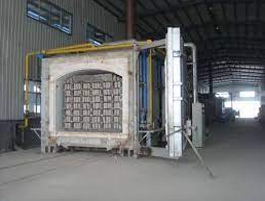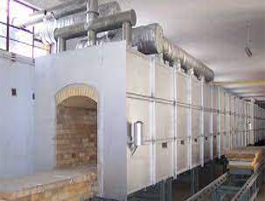call Us
+91 95103 25696
E-mail us
vinod.s@teknikengineers.in

Kiln & Furnace
Furnaces and kilns are similar in design and similar to dryers. The main difference is that dryers only have a metal casing, while furnaces and kilns have refractory bricks for insulation. Each device on this page has a general description, product information, usage examples, and advantages / disadvantages.
Kiln
Pottery refers to the production of glass or ceramic products. These are usually fired at an increasing rate from room temperature to a given process and then allowed to cool back to room temperature at a controlled rate. The rate of increase (or decrease) during fire and air conditioning is often very significant. Removed items are rarely removed from the device while the device is running. There may be a temperature hold time during ignition, but the holding time is usually negligible relative to the total ignition time. The temperature range is 1700°F - 2350°F.
Shuttle Kiln: A shuttle kiln is an electric kiln that fires the product in a kiln car enclosed in a kiln. The temperature control of the oven is automatic and the best cooking conditions are set. In addition to oxidative firing furnaces, NGK also supports reduced air furnaces. We also offer high temperature fire extinguishers with a maximum temperature of 1,830 °C.

Tunnel Kiln: A shuttle kiln is an electric kiln that fires the product in a kiln car enclosed in a kiln. The temperature control of the oven is automatic and the best cooking conditions are set. In addition to oxidative firing furnaces, NGK also supports reduced air furnaces. We also offer high temperature fire extinguishers with a maximum temperature of 1,830 °C.

Furnace
Combined with forged or heat treated steel. These are usually kept at the same temperature for a long time. The fact that the temperature rises during the heating season is less important. Baked goods are usually added to or removed from the oven while the appliance is hot. During cooking, the temperature is usually maintained for a long time, and there may be various cooling and holding times, including annealing, surface hardening, and tempering. The temperature range is 2000°F - 2450°F.
Heating: Furnace serves many purposes. In an induction furnace, heat is produced using an electric current that sends alternating current through a coil that creates a magnetic field. When the workpiece is placed in the coil, the magnetic field induces an eddy current. It may include equipment such as fuel gas, fire extinguishers, electrical equipment, electrical equipment, electrical or plumbing.

Melting: The induction melting furnace works on a different principle than the cupola version. They use helical heating elements inside the crucible or integrated into the walls of the heating chamber. These convert electrical energy into heat, which is electricity, through material with excellent thermal uniformity.

Get in touch
You will find yourself working in a truly collaborative environment, resulting in an incredible experience and the best end product.
